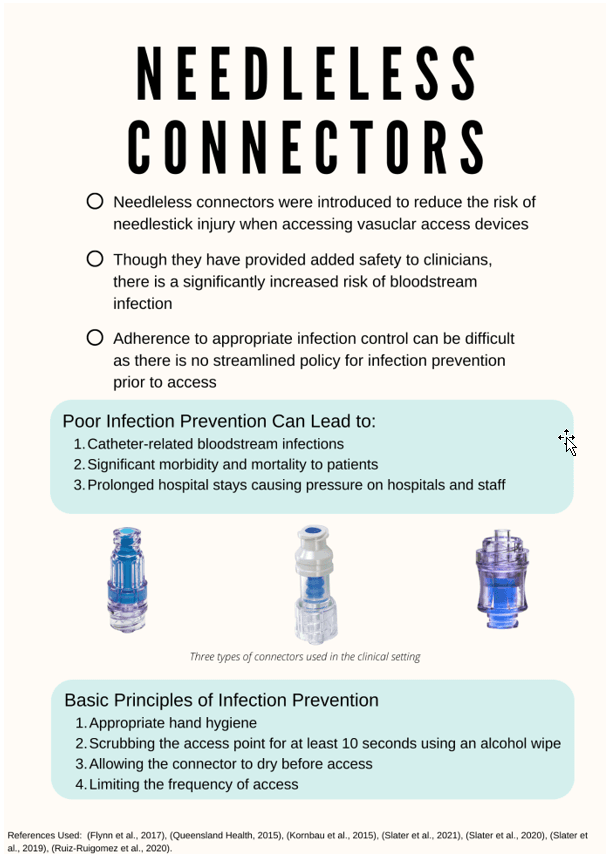Essentials of Needleless Connector Care
)
Introduced in the 1990s, needleless connectors have become an essential component of 21st century medical care, as they have removed the inherent needle stick injury risk associated with older needle-based connectors.1 Used on both central and peripheral vascular access devices, they allow for the safer administration of medication, fluid and blood.2
However, needleless connectors carry a significantly increased risk of bloodstream infection. If the injection site has not been properly cleaned before accessing, pathogens can infiltrate the vascular access device and enter the bloodstream.3
This increased risk of bloodstream infection is concerning not only due to the increased risk of morbidity and mortality to the patient, but also due to the prolonged hospital admission and pressure placed on the healthcare sector while the patient recovers from this hospital-acquired infection.4
As such, the importance of appropriate hygiene must be emphasised, in order to ensure that microbes are not being injected into the vein.3 Issues however arise due to confusion of appropriate cleaning techniques, products, and drying times.5 For instance, Queensland Health guidelines states that the manufacturer's policy should be followed, which in itself is difficult to access.6 As a result of conflicting evidence and guidelines, accessing the port is often left to the discretion of the clinician, which presents the potential for significant issues.5
The 2021 Infusion Nurses Society Standards recommend the needleless connector should be scrubbed for at least 5 seconds,7 with recent studies showing no difference in microbial colonisation when using 70% isopropyl wipes or chlorhexidine in alcohol wipes.1 Drying times also vary significantly, with 5 seconds for isopropyl alcohol and 20 seconds for chlorhexidine in alcohol.8 Povidone-iodine takes over 6 minutes to dry and is not suitable for cleaning needleless connectors.8 Isopropyl alcohol impregnated caps are gaining in popularity, but need more robust evidence to support their widespread use.
In addition, clinicians should be aware of when to change the connector. The 2021 INS Standards recommend that this change should occur no more often than every 96 hours, unless it is removed and as such cannot be reattached, or if the connector is contaminated with blood or other substances, to reduce the risk of catheter-associated infection.7
References
1. Slater K, Cooke M, Fullerton F, Whitby M, Hay J, Lingard S, . . . Rickard CM. Peripheral intravenous catheter needleless connector decontamination study-Randomized controlled trial. Am J Infect Control 2020;48(9):1013-1018
2. Slater K, Cooke M, Whitby M, Rickard CM. Needleless connector nursing care - Current practices, knowledge, and attitudes: An Australian perspective. Infect Dis Health 2021;10.1016/j.idh.2021.04.004
3. Slater K, Cooke M, Scanlan E, Rickard CM. Hand hygiene and needleless connector decontamination for peripheral intravenous catheter care-time and motion observational study. Am J Infect Control 2019;47(8):1017-1019
4. Ruiz-Ruigomez M, Fernandez-Ruiz M, San-Juan R, Lopez-Medrano F, Orellana MA, Corbella L, . . . Aguado JM. Impact of duration of antibiotic therapy in central venous catheter-related bloodstream infection due to Gram-negative bacilli. J Antimicrob Chemother 2020;10.1093/jac/dkaa244
5. Flynn JM, Keogh S, Zhang L, Rickard CM. Evaluating methods for effective decontamination of central venous access device needleless connectors in adult hospital patients: A pilot randomised controlled trial protocol. Vascular Access 2017;3(2):8-13
6. Queensland Health. Peripherally Inserted Central Venous Catheters (PICC); 2015; Available from: https://www.health.qld.gov.au/_data/assets/pdf_file/0032/444497/icare-picc-guideline.pdf.
7. Gorski L, Hadaway L, Hagle M, McGoldrick M, Orr M, Doellman D. Infusion therapy standards of practice. J Infus Nurs 2021;44.
8. Slater K, Fullerton F, Cooke M, Snell S, Rickard CM. Needleless connector drying time-how long does it take? Am J Infect Control 2018;46(9):1080-1081
Other
Kornbau C, Lee KC, Hughes GD, Firstenberg MS. Central line complications. Int J Crit Illn Inj Sci 2015;5(3):170-178
| Tags:infection preventionneedleless connectorcatheter-associated bloodstream infection |








